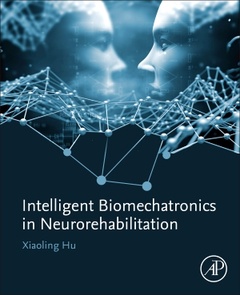Intelligent Biomechatronics in Neurorehabilitation
Auteur : Hu Xiaoling

Intelligent Biomechatronics in Neurorehabilitation presents global research and advancements in intelligent biomechatronics and its applications in neurorehabilitation. The book covers our current understanding of coding mechanisms in the nervous system, from the cellular level, to the system level in the design of biological and robotic interfaces. Developed biomechatronic systems are introduced as successful examples to illustrate the fundamental engineering principles in the design. The third part of the book covers the clinical performance of biomechatronic systems in trial studies. Finally, the book introduces achievements in the field and discusses commercialization and clinical challenges.
As the aging population continues to grow, healthcare providers are faced with the challenge of developing long-term rehabilitation for neurological disorders, such as stroke, Alzheimer?s and Parkinson?s diseases. Intelligent biomechatronics provide a seamless interface and real-time interactions with a biological system and the external environment, making them key to automation services.
Part I. Neural Coding Mechanisms1. Neural Coding at Cellular Level2. Neural Coding by Electrocorticography (ECoG)3. Neural Coding by Electroencephalography (EEG)4. Neuromuscular Coding by Electromyography (EMG)
Part II. Biomechatronic Systems5. Rehabilitation Robots with Brain Computer Interface (BCI)6. Bionic Robotics for Amputees7. Voluntary Intention Driven Rehabilitation Robots for the Upper Limb8. Integration of Sensory Stimulation into Robots9. Robotic and Functional Electrical Stimulation (FES) Hybrid System
Part III. Clinical Applications and Commercialization10. Clinical Evaluations by Robots in Rehabilitation11. Clinical Trials on Rehabilitation with Voluntary Intention Driven Robots13. Automation in Neurorehabilitation: Needs Addressed by Clinicians14. Commercialization of rehabilitation robotics: Chances and Challenges15. Comparison on the Rehabilitation Effectiveness between Trials and Real Services
- Written by international experts in the rehabilitation and bioinstrumentation industries
- Covers the current understanding of nervous system coding mechanisms, which are the basis for biological and robotic interfaces
- Demonstrates and discusses robotic rehabilitation effectiveness and automatic evaluation
Date de parution : 10-2019
Ouvrage de 286 p.
19x23.3 cm
Thèmes d’Intelligent Biomechatronics in Neurorehabilitation :
Mots-clés :
2013 Hong Kong financial report; Academia; Acquired brain injury; Automation; Award winning competition; Biomimicry; Brain control; Brain plasticity; Brain–computer interfaces (BCIs)Electrocorticography (ECoG)Hand gesture decoding; Cable drive system; Cable-based; Certified bodies; Chinese manufacturer; Clinical service; Cognitive rehabilitation; Commercialization; Drosophila larva; EEG; Electrical impedance myography; Electrocorticography stimulation; Electrode reduction; EMG; EMG-driven control; Fabricator; Financial investor; Gait analysis; Gait training; Government; Grand prix award; Gravity compensation; Hand of Hope; Hong Kong science park; Industry; Intellectual properties; Intracortical microstimulation; Invasive brain–machine interface; Investor pitching; IP; ISO-13485Market-oriented approach; Linear state-space model; Lower limb; Mergers and acquisitions; Motor compensation; Motor recovery; Motor unit; Movement analysis; Movement control



